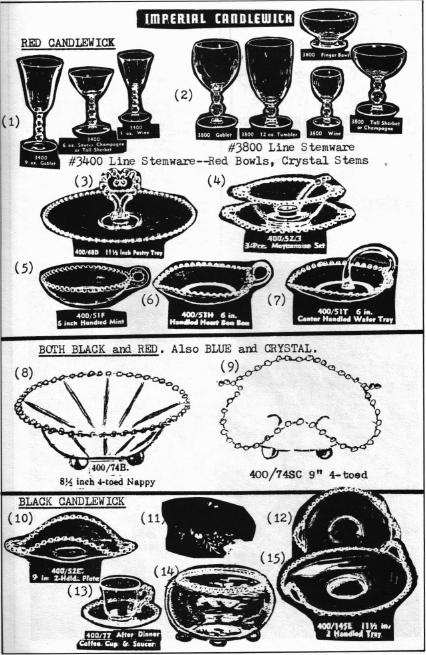National Depression Glass Association
Preserving America's Glass Manufacturing Heritage
Colored Candlewick: Part II
by Virginia Scott
Glass Review - November 1982
On a trip to Imperial Glass Corporation in 1977, I was told by Miss Lucille Kennedy, Marketing Manager of Imperial, that very little is known about when colored Candlewick was made or what colon were produced. The information I have has come mainly from collectors and glass dealers who have written me about their finds.
 RED CANDLEWICK
RED CANDLEWICK
Although I had heard about a piece or two of red Candlewick, the first that I knew of it personally was when a local lady brought red stemware for me to identify. Imagine my surprise and delight when I saw that it was 3400 Line Candlewick (no. 1) with red bowls and crystal stems! Several people have since found more 3400 Line red goblets, sherbets and wines. 3800 Line Candlewick has also been reported in red with crystal stems (no. 2). One dealer found forty-nine pieces, including goblets, ice teas (1-bead), sherbets, wines and even finger bowls. Two or three others have found smaller amounts, goblets and sherbets. 3800 Line Candlewick was made in the late 1930's and early 1940's only.
I believe that most of the red pieces were made in the late 1930's. This date would seem right for the 400/748 and 74SC 4-toed bowls, no. 8 and 9. It would also fit for 3400 Line stemware, the pastry tray, 400/68D (no. 3), the 400/51F Mint (no. 5) and the 400/52 mayonnaise set (no. 4). It seems probable, however, that some of the red pieces would have been produced at a later date. The 400/51T wafer tray, no. 7, is not shown in the catalogs until about 1947. This wafer tray and the other 400/51 items, no. 5 and 6, are red with clear applied handles. Items with red flashing and red beads will be discussed in a later article.
I have information from a collector who attended the 1981 Imperial Glass Collector's Society Convention that the banquet speaker, who has been chief chemist at Imperial, said in his speech that red Candlewick was made for only a very short time in the late 1930's. The reason for this, he explained, was that red glass is yellow until it is re-fired in the "glory hole" and when Candlewick is re-fired, the beads tend to distort.
BLACK CANDLEWICK
Black Candlewick must have been made in the late 1930's also, as most of the black pieces that have been found have been early pieces, including the 400/74B and 74SC bowls, nos. 8 and 9. Both of these bowls have been found in red, black and light blue as well as crystal.
A few other black pieces have been reported. Two or three people have found the black 400/52E plate or tray which has turned up sides (no. 10). An opaque 400/77AD demi-cup and saucer has been found (no. 13).
Several pieces of black Candlewick with hand-painted flowers (no. 11) have been reported. These include a 400/145E tray with turned-up handles (no. 15); a 400/62D handled plate (no. 12); a large crimped bowl; and a 4-toed bowl with curved-in top (no. 14). It is interesting that no large crimped bowls nor that particular 4-toed bowl are shown in any Candlewick catalog that I have seen. The decoration consists of large flowers in gold, small flowers in white with red center and gold leaves. The beading on the edge of most of the pieces is also gold.
It is known that in the late 1970's, Imperial experimented with making solid black goblets from the 3400 Line. These were never marketed but were sold through the Imperial Hay Shed outlet store at the Imperial plant.
In my next article, I will discuss some of the miscellaneous colors and pieces. Perhaps there will also be room to discuss some of the cuttings and decorations found on Candlewick. I am always interested in hearing about any colored Candlewick you find.